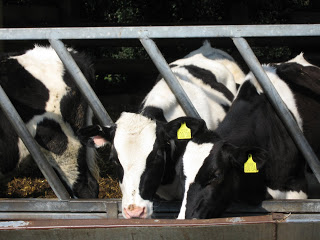HELENA, Mont. (AP) — Federal officials looking to head off livestock disease outbreaks are drafting regulations that would require farmers to identify animals that move across state lines.
The aim is to reduce illness and deaths by making it easier for officials to trace brucellosis, tuberculosis and other diseases to a particular group of animals, location and time.
The regulations are being drafted six months after the U.S. Department of Agriculture dropped an unpopular voluntary program meant to trace livestock movement, and they are expected to be implemented in 2013.
“A voluntary system has not worked so far, and that’s why the USDA has gone back to the drawing board and created a system that relies much more strongly on compulsory or mandatory identification instead of voluntary,” said Marty Zaluski, the Montana state veterinarian and a member of the USDA working group drafting the new rule.
Last year, more than 19 million of the nation’s 30 million beef cows and 9 million dairy cows crossed state lines.
Data from 2006 and 2007 show that only 28% of the nation’s adult cattle had any form of official identification that would allow them to be tracked, said David Morris of the USDA’s Animal and Plant Health Inspection Service.
States will have authority to decide how to track livestock moving within their own borders, but they will be accountable to the federal government for the system they choose.
Accountability standards would be created to make sure the state systems are working, Morris said. The aim is to make the regulations flexible, but also to develop and maintain standards.
“How can you be flexible and still have a standard? We’re working our way through those (issues) and still trying to provide options and still trying to progress toward not having 50 different systems in 50 different states,” Morris said.
The National Animal Identification System, begun in 2004, aimed to pinpoint an animal’s location within 48 hours of a disease being discovered. But the voluntary program got less than a 40% participation rate among farmers and ranchers. They complained the cost was too high, that it was too intrusive and involved too much bureaucratic red tape.
John Baucus, who owns a sheep, cattle and goat ranch north of Helena, said he did not sign up for the program because of the mixed nature of the discussions on its direction and future.
“If they finally decide they want a national identification system, we’ll get a number,” Baucus said.
The USDA dropped the program in February. But the need to trace animals in case of disease outbreak remains, which led to the proposed rule being drafted, Morris said.
“Noticing those trends and other disease programs successes, quite frankly, we recognize that we do need to enhance our ability to respond to those diseases both present and emerging and yet to be discovered,” Morris told a small group at a Helena public hearing on the proposed regulations last week .
Besides dealing only in interstate commerce, the new federal regulation would also require animals to have a certificate of health from veterinarian — with some yet-undefined exceptions.
Official animal identification tags could come from three places: the National Uniform Ear Tagging System utilized by programs such as brucellosis prevention; the 15-digit international standard numbering system; or a numbering system compatible with the USDA’s National Scrapie Eradication Program for sheep and goats.
Two or more states could agree among themselves to accept brand inspections as official identification, but creating and implementing that system would be in the states’ hands, not the federal government’s, Morris said.
With the inclusion of branding, the new proposal is a positive step from the NAIS model, said Errol Rice, vice president of the Montana Stockgrowers Association. Branding is the area of biggest concern for his organization’s members, he said.
“They want to make sure that they continue recognition of the hot iron brand as a method of identification,” Rice said. “Any layer of traceability above that needs to be economically feasible.”
About 1 million head of cattle are exported from Montana to feedlots each year, Rice said.
USDA is holding a series of public meetings on the proposed regulations and plans to have a draft rule ready in April 2011. The final rule is expected to be published a year to 15 months after that, with full implementation a year after the final rule is published.
Source: usatoday.com


Be the first to comment on "USDA plans to require ID for interstate livestock"